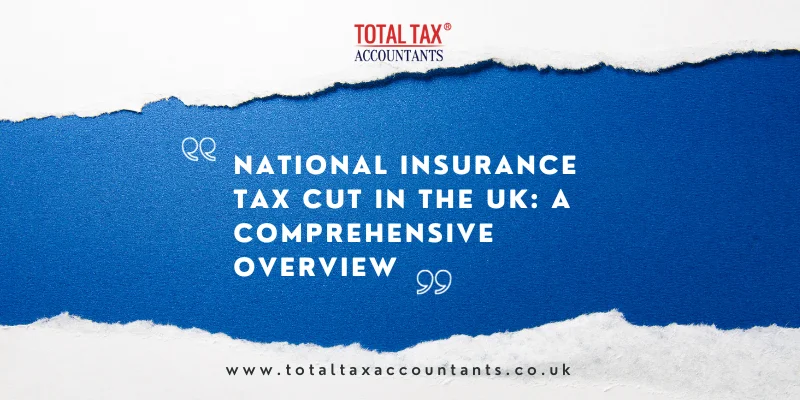Introduction: A Shift in Fiscal Policy
From 6th January 2024, the UK ushers in a new era of tax relief with a major reduction in National Insurance (NI) rates. This pivotal move marks a significant fiscal shift, reducing the main employee National Insurance rate from 12% to 10%. Impacting around 27 million UK residents, this adjustment represents a substantial decrease in NI contributions, offering notable savings for workers across various sectors.

Government’s Perspective and Economic Strategy
Prime Minister Rishi Sunak and Chancellor Jeremy Hunt have framed this tax cut as a response to economic challenges, including the pandemic and geopolitical tensions. They emphasize that these tax reductions are a reward for the hardworking population, aiming to boost disposable income and enhance quality of life. This strategy aligns with the broader goal of stimulating economic growth by returning more money to the public.
Impact on Workers and Economic Recovery
The tax cut promises immediate financial benefits for workers. For example, a full-time nurse might save £520 annually, while a junior doctor could see around £750 in savings. This broad spectrum of savings underscores the government’s effort to lessen the financial burden on its workforce. The reduction in NI contributions comes against the backdrop of a recovering economy, with inflation rates halving and a steady decrease in national debt.
UK’s Competitive Edge and Additional Reforms
The UK now boasts lower personal taxes for average earners than any other G7 country, enhancing its global economic position. This cut is part of a series of tax reforms, including a substantial increase in the National Insurance personal allowance in July 2022. Further tax reductions are anticipated, including a cut for self-employed individuals from April 2024.
HMRC’s Innovative Financial Planning Tool
HM Revenue and Customs (HMRC) has launched an online tool providing personalized estimates of potential NI savings. This tool aids employees in understanding the tax changes and planning their finances more effectively.
Historical Context and Future Projections
The National Insurance tax cut is not isolated but part of broader tax reforms aimed at reducing taxpayers’ burden. Looking forward, the government outlines additional tax reductions and projects significant increases in the National Living Wage.
Varied Benefits Across Income Brackets and Economic Implications
The benefits of the tax cut are not evenly distributed across income brackets. The Resolution Foundation suggests that those earning around £50,000 will benefit the most, while lower-income earners might find the tax cut offset by the tax rise due to the freeze in personal tax thresholds. Despite the NI cut, the broader tax context presents a more complex picture, with the ongoing freeze in income tax and NICs thresholds potentially leading to overall tax increases for many by 2027-28.
Public and Expert Opinions
Economists and financial experts have raised concerns about the broader tax context of this cut. The Labour party criticizes the government’s approach, highlighting increasing tax burdens despite the NI tax cut. The business sector, while acknowledging the Chancellor’s efforts, calls for more decisive action to stimulate economic growth.
Benefiting from the National Insurance Tax Reduction
The National Insurance tax reduction in the UK offers significant financial advantages to diverse professionals. Here’s how various roles are impacted:
- Senior nurses with five years’ experience and a £42,618 salary will see a yearly income increase of £600.
- Average full-time nurses, earning £38,900, will enjoy a yearly rise of over £520.
- Police officers with a typical £44,300 salary are set to gain over £630 annually.
- Junior doctors, earning about £63,000, can expect an increase exceeding £750 each year.
- Night shift cleaners on a £21,000 salary will benefit from an additional £170 per year.
- Self-employed plumbers, with incomes around £34,400, are projected to see a £410 annual rise.
- Teachers, averaging £44,300 in earnings, will get over £630 more each year.
- Dual-earner families, each earning £35,404, will find themselves £900 better off annually.
These statistics underscore the tax cut’s significant role in enhancing the financial health of a wide spectrum of UK workers.”
Final Thoughts: The Mixed Impact on UK Taxpayers
The National Insurance tax cut presents a mixed picture for UK taxpayers. While it brings immediate financial relief, the broader fiscal context, including the freeze on personal income tax thresholds until 2028, may offset these benefits. The net impact of these changes leaves employees earning below £26,000 annually either worse off or unaffected, while those earning above this threshold, especially around £50,000, stand to benefit the most. This complex scenario illustrates the varying impact of the National Insurance tax cut across different income groups.


